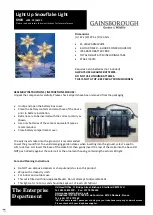
Using Alternate Line, Knots and Splices
Lashing line minimum breaking load
Strands
lb
kg
1
2000
907
2
1000
454
3
667
302
4
500
227
5
400
181
6
333
151
7
286
130
8
250
113
9
222
101
10
200
91
Six (6)
strands
Harken is not liable or responsible for use of line used to secure blocks. Go to Harken Limited
Warranty at www.harken.com for complete details. It is your responsibility to choose the correct line
for the block. When choosing line, use a breaking load that exceeds the block's breaking load to
account for strength loss from:
1. Knots slipping or breaking under load much lower than line's breaking load. Spectra
®
or
Dyneema
®
type lines require specialized knots.
2. Splices slipping or failing due to incorrect splice or execution.
3. Increasing UV damage
4. Chafing
If you are not comfortable choosing line, work with a qualified rigger.
Go to www.harken.com/knots for additional information.
IMPORTANT! Fewer lashing strands require line with higher breaking load.
Notes
A breaking load of 2000 lb (900 kg)
can be achieved by using:
Fewer strands of higher-strength line
OR
More strands of lower-strength line
Check fit of lashing line in block mouth
Dyneema is a registered trademark of DSM Dyneema.
Spectra is a registered trademark of Honeywell International, Inc.
Lashing to Bail Using Harken-Supplied Line
Note sheave direction of rotation when block is under load in ratchet mode. Make sure the block
is facing the correct way before lashing. Use three laps to create six strands. Tie ends using double
fisherman's knot or other secure knot. Knot can also be located on side of block. Photos are not
intended to teach this knot. See www.harken.com/knots or consult a knot-tying book. IMPORTANT!
If you are not comfortable tying this or any other knot, get help from a professional rigger.
Lashing 90°
To lash block at 90°, cross
lines each pass similar to
lashing to boom.
5
See next page. Read important information on choosing line,
knots and splices at: www.harken.com/knots.
























